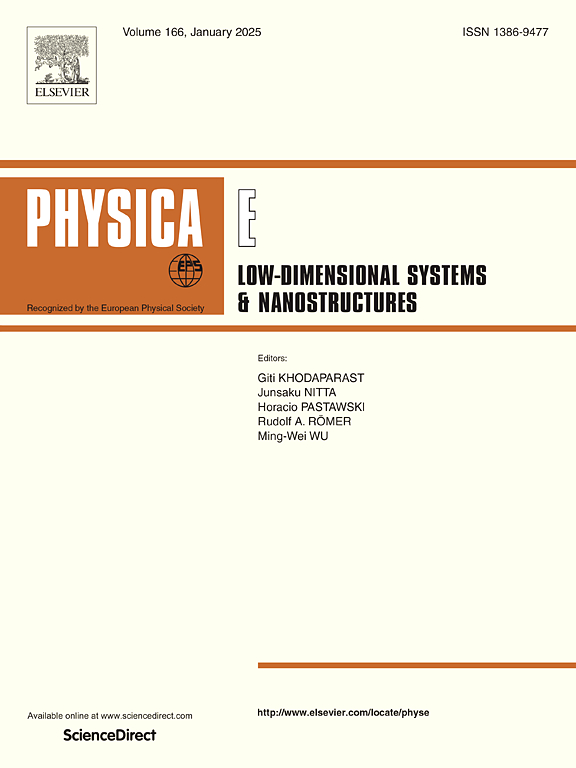从二维到一维的β-萘:一种将石墨烯和萘合并的多孔碳同素异形体
IF 2.9
3区 物理与天体物理
Q3 NANOSCIENCE & NANOTECHNOLOGY
Physica E-low-dimensional Systems & Nanostructures
Pub Date : 2025-07-07
DOI:10.1016/j.physe.2025.116316
引用次数: 0
摘要
二维(2D)碳基材料由于其多样化的结构和电子特性而引起了相当大的兴趣,使其成为下一代平面电子产品的理想选择。在这些材料中,类金属多孔结构具有可调电荷传输和高表面积等优点,这对储能应用至关重要。在这项研究中,我们引入了β-萘,一种新型的二维碳同素异形体,由萘单元通过八角形环连接而成。第一性原理计算证实了其动力稳定性和热稳定性,证明了其理论可行性。此外,我们发现杨氏模量在43.71 N/m到165.88 N/m之间,表明力学响应是各向异性的。光学分析揭示了红外(IR)和紫外(UV)区域的吸收活性。还分析了衍生的一维结构,揭示了狄拉克锥和从金属到半导体行为的转变。这些发现表明β-萘是一种很有前途的储能和光电子技术材料。本文章由计算机程序翻译,如有差异,请以英文原文为准。
From 2D to 1D in β-naphthyne: A porous carbon allotrope merging graphyne and naphthylene
Two-dimensional (2D) carbon-based materials have attracted considerable interest due to their diverse structural and electronic properties, making them ideal for next-generation flat electronics. Among these materials, metallic-like porous structures offer advantages such as tunable charge transport and high surface area, which are essential for energy storage applications. In this study, we introduce -naphthyne, a novel 2D carbon allotrope composed of naphthyl units interconnected by octagonal rings. First-principles calculations confirm its dynamic and thermal stability, demonstrating its theoretical feasibility. Furthermore, we demonstrate that Young’s modulus ranges from 43.71 N/m to 165.88 N/m, indicating an anisotropic mechanical response. Optical analysis reveals absorption activity in the infrared (IR) and ultraviolet (UV) regions. The derived 1D structures were also analyzed, revealing a Dirac cone and a transition from metallic to semiconducting behavior. These findings establish -naphthyne as a promising material for energy storage and optoelectronic technologies.
求助全文
通过发布文献求助,成功后即可免费获取论文全文。
去求助
来源期刊
CiteScore
7.30
自引率
6.10%
发文量
356
审稿时长
65 days
期刊介绍:
Physica E: Low-dimensional systems and nanostructures contains papers and invited review articles on the fundamental and applied aspects of physics in low-dimensional electron systems, in semiconductor heterostructures, oxide interfaces, quantum wells and superlattices, quantum wires and dots, novel quantum states of matter such as topological insulators, and Weyl semimetals.
Both theoretical and experimental contributions are invited. Topics suitable for publication in this journal include spin related phenomena, optical and transport properties, many-body effects, integer and fractional quantum Hall effects, quantum spin Hall effect, single electron effects and devices, Majorana fermions, and other novel phenomena.
Keywords:
• topological insulators/superconductors, majorana fermions, Wyel semimetals;
• quantum and neuromorphic computing/quantum information physics and devices based on low dimensional systems;
• layered superconductivity, low dimensional systems with superconducting proximity effect;
• 2D materials such as transition metal dichalcogenides;
• oxide heterostructures including ZnO, SrTiO3 etc;
• carbon nanostructures (graphene, carbon nanotubes, diamond NV center, etc.)
• quantum wells and superlattices;
• quantum Hall effect, quantum spin Hall effect, quantum anomalous Hall effect;
• optical- and phonons-related phenomena;
• magnetic-semiconductor structures;
• charge/spin-, magnon-, skyrmion-, Cooper pair- and majorana fermion- transport and tunneling;
• ultra-fast nonlinear optical phenomena;
• novel devices and applications (such as high performance sensor, solar cell, etc);
• novel growth and fabrication techniques for nanostructures

 求助内容:
求助内容: 应助结果提醒方式:
应助结果提醒方式:


